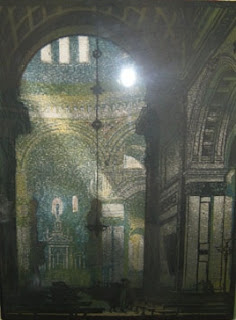Emily Gladys Court
(1880-1957)
British painter,
student of Slade School of Art London.
student of Slade School of Art London.
The privilege of being a Blog writer, a Blog owner and editor combined in one person is one can do as one pleases. Without Murdochian ambitions. Like today interrupting the Antwerp related series of postings wandering off and sharing some nice discoveries that I made along my researching Verpilleux's St.Pancras Railway Station print. And finding my way in London's foggy atmosphere. Meeting some of the of the great French impressionist painters along the banks of foggy River Thames. And some early iconic photographers. Wait untill I speculate over Verpilleux's prints "view from Waterloo Bridge" and "the British Museum" in next Antwerp School episode.
But let me first share these atmospheric impressions by some Lesser Gods of Impressionist Painting.
 |
| Emily Court , St.Pancras Station |
 |
| Emily Court , Cannon street Station View from Southwark Bridge |
 |
| Emily Court, "View along the railway track" |
Algernon Mayow Talmage
(1871-1939)
British painter and postermaker.
he also decided painting inside Cannon street Station. Like in St. Pancras here're also the waiting horse and cariages inside the station. Great painting !
 |
| Cannon street Station |
 |
| St. Pancras Railway Station |
Pietro Sansalvadore
(Turin 1892-1955 London)
born in Italy but decided to stay in London painted Cannon street Station from the other bank (also probably from Southwark Bridge).
 |
| Cannon street Station and railway bridge. |
(1856-1931)
Roberts left with his family for Australia, came back to England to study at London Art School, returned to Australia and became one of Australia's famous and influential painters. In 1915 (aged 59) he again returned to London to work in the 3th London Hospital in Wandsworth in the War effort. Not far from were he painted in a few strokes this little Thames impression on the back of a cigar box..
 |
| House of Parliament seen from the Victoria embankment |
Leo Lesser Ury
(1861-1931)
German impressionist painter.
 |
| 3 London bridges, viewed from the Savoy or Cecile Hotel Waterloo, Hungerford railway and Westminster bridges Cleopatra's Needle not shown. |
German impressionist Leo Lesser Ury also visited London and I think these lesser known impressions by him match any of Monet's and Whistler's far more known and famous foggy interpretations. How much more "atmospheric" can you get? If it is painted from the Savoy or Cecile Hotel; Walker's (lead)Shot tower on the South bank in the centre. Ury loved painting "nocturnes" (Whistlers trademark) and was also famous, called a master, for painting/drawing with pastel. He made great atmospheric nocturnes and rain-paintings of his hometown Berlin and of Paris. But London: what better place to be on:
(click the link above)
And what greater images closing 2011?
A happy New Year and best wishes to all readers.
I shall continue with Antwerp School and Emile Verpilleux first thing in
2012
This posting is not supposed to give a complete overview of impressionist paintings of London and the Thames. These pictures I've stumbled upon and I hope you are as surprised by them as I am. And like them as much as I do.
Leaving a comment is always much appreciated and encouraging continuing in 2012.














































